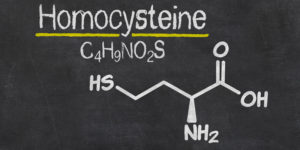Spotlight On:
Homocysteine: A Key Marker for Heart and Brain Health
What is it? What are its effects? What levels are healthy?
What is Homocysteine?
Homocysteine (Hcy) is a sulfur-containing amino acid. Amino acids are the building blocks for protein – they are strung together in long chains to make protein.
Hcy lies at the midway point between two other amino acids: methionine and cysteine. Hcy doesn’t have a role as a protein building block. It’s a relay station – it converts to either methionine or cysteine as needed. Hcy can build up if its conversion to either is impaired or blocked. Homocysteine can be measured with a blood test.
What Should My Hcy Level Be?
A normal Hcy level is considered to be less than 15 micromoles per liter (μmol/L). Studies show, however, that levels as low as 10 μmol/L raise the risk of Alzheimer’s Disease (Clarke R, Smith AD, Jobst KA, Refsum H, Sutton L, Ueland PM Arch Neurol. 1998 Nov; 55(11):1449-55). I recommend a goal of homocysteine less than 8 μmol/L.
What’s Wrong with Having Too Much Hcy?
High levels of Hcy are correlated with higher rates of heart disease, and of dementia. Studies have shown that Hcy at high levels contributes to inflammation and endothelial dysfunction in arteries. Endothelial dysfunction means that artery walls don’t contract and relax properly, potentially leading to high blood pressure and/or damage to the artery wall (Ganguly P, Alam SF. Role of homocysteine in the development of cardiovascular disease. Nutr J. 2015;14:6).
High Hcy has also been associated with dementia, either as a cause or a secondary finding in cases of dementia. Homocysteine appears to contribute to cognitive decline through various means:
- Damage to blood vessels in or supplying the brain (vascular)
- Increasing production of amyloid plaque and/or neurofibrillary tangles (inflammation)
- Atrophy (shrinkage) of memory centers in the brain (temporal lobe)
- Altering genetic expression to cause more damaging forms of amyloid and tau that choke off healthy parts of the brain
(Smith AD, Refsum H, Bottiglieri T, et al. Homocysteine and Dementia: An International Consensus Statement. J Alzheimers Dis. 2018;62(2):561-570).
How Can We Develop Too Much Hcy?
As the diagram below shows, several players are involved in regulating homocysteine conversion. You don’t need to be familiar with any of them, but you will likely recognize some. (Click on the image to expand it).
The most important nutritional players are folate, B12 and B6, along with dimethylglycine (DMG), another amino acid.
Methylation: Folate and B12
We need folate and B12 to recycle Hcy back to methionine. You can see the terms “methyl” and “methylation” in the diagram above. These refer to CH3 groups attached to molecules. Methionine is a methyl donor, and homocysteine needs to be remethylated to be recycled back to methionine. Folate (or folic acid) donates a methyl group to B12, which then attaches to homocysteine, making methionine.
The Role of MTHFR
You can see to the left in the diagram the terms “5,10 Methyl THF” and “MTHFR”. These refer to forms of folate and enzymes which, in most people, produce the form of folate which gives a methyl group to B12. Some people have mutations in the genes which code for these enzymes, and don’t produce the active form of folate. Those of you who have had the MTHFR genetic test done know your status.
If you have a mutation in one or more of these genes, you are less likely to be able to effectively recycle homocysteine, and should be taking an active form of folic acid called 5-MTHF, or L-methylfolate. Many people with this mutation have higher than normal levels of homocysteine.
B12 Deficiency and Homocysteine
If you are a vegan, have celiac disease or other forms of malabsorption, are taking a proton pump inhibitor (PPI) for heartburn/reflux, or metformin for insulin resistance/diabetes, you should check your B12 level, using a serum B12 test and/or the methylmalonic acid (MMA) test. All of these are potential contributors to B12 deficiency. If you have a low level, even if your Hcy level is normal, I strongly encourage you take a sublingual supplement or get B12 injections.
The Role of B6
Vitamin B6 helps with the sulfuration pathway that converts Hcy into cysteine. Taking a multivitamin with 25 mg of B6 a day will usually take care of any deficiencies that you may have of this important vitamin.
Food Sources of Folate, B12 and B6
Folate:
-
- Leafy greens, including spinach and romaine
- Sprouted legumes (mung bean, lentil, chickpea, etc.)
- Cauliflower, asparagus, broccoli, kale, cabbage
- Strawberries, other berries
- Oranges, grapefruit, and their juices
- Fermented foods such as kefir, water kefir, sauerkraut
- Brewer’s yeast
- Peas
- Sweet peppers
- Beef liver
- B12
- Animal products (meat, dairy, eggs, fish, shellfish)
- Beans and peas (less so)
- Fermented soy products (tempeh, soy sauce)
- Seaweed
- Fortified grains, cereals, breads
- B6
- Pork, poultry, eggs, wholegrain cereals/flour, vegetables
For those with high homocysteine (over 10 μmol/L), I recommend supplementing with a combination product with 5-MTHF, Methyl B12, and active B6 (P5P). You can contact my office or visit my online dispensary Wellevate to browse products. Enter the search term “homocysteine” to view the selection.
Kidney Disease and Homocysteine
Chronic kidney disease can interfere with the body’s ability to eliminate Hcy, sometimes to a dramatic degree. If your Hcy level is high, your doctor will consider kidney disease as a possible cause.
Conclusion
Homocysteine is a risk factor for heart disease and cognitive decline. Many factors can contribute to high levels of this amino acid. Adequate levels of activated folate, B12 and B6, along with dimethylglycine, typically restore an elevated Hcy to a desirable level.


